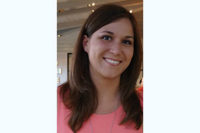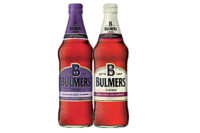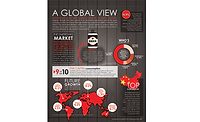Western Europe: A Mature Market
By ELIZABETH FUHRMAN
Region finds some beverage category sales struggling
Health and wellness options are a theme being taken up across the globe, and Europe is finding health concerns impacting the sales of the total alcohol category, which still contains the area’s largest selling categories. In many European countries, the increasing consumer trend toward a healthier lifestyle continues to grow demand for functional beverages that offer physical or mental well-being, lower calories and other added values.
Western Europe’s beverage market grew to more
than $500 billion in 2006, led by beverages sales in France, Germany and
the United Kingdom, according to Euromonitor International, Chicago. While
the category may be struggling in particular areas of Europe, beer still
leads beverage sales, and grew 6.8 percent from 2001 to 2006 to more than
$143 billion, Euromonitor says.
In Western Europe, wine ranked second with more than
$199 billion, and spirits grew to nearly $81 billion. The categories that
grew the most, according to Euromonitor data, are ready-to-drink coffee,
which grew 292.1 percent between 2001 and 2006, and functional drinks,
which increased 89.8 percent during the same time period. RTD coffee is
still a small category, however, and ranked last in top beverage category
sales in Western Europe with $394 million.
The countries that are leading in beverage sales also
are leading in new product introductions. In 2006, United Kingdom
beverage-makers released 803 new products, French producers debuted 784 and
German beverage companies ranked third with 653 new offerings. From 2005 to
2006, the number of new product launches in the United Kingdom were down
38.7 percent in 2006, but are already slightly up for the year, as of Aug.
31, 2007. France also saw a slight dip in new product launches (down 2.4
percent from 2006 to 2005), and it appears the trend will continue for
2007.
Non-carbonate performance
Market maturity in Western Europe and the rise of
non-carbonates, particularly bottled water, are
slowing the growth of juices and nectars, according to Canadean, based in
the United Kingdom. Perceived as a better-for-you category, juice sales in
the region are still on the rise.
Additionally, growing consumer health-consciousness
significantly impacted the category, with regional differences in diet
trends translating into different sales trends, according to Mintel Reports
— Fruit Juice and Juice Drinks U.K., published in November 2006. For example, juice sales in
the United Kingdom have climbed in reaction to government-sponsored
awareness campaigns that encourage the British to boost their consumption
of fruit and vegetables.
Soft drinks
Overall soft drink growth across Western Europe for
2006 grew at just less than 3 percent, according to Canadean. Bottled water
was the key volume contributor (with water sales in Germany soaring).
Sports and energy drinks also were particularly active, and fueled by
distribution expansion and general brand awareness, Canadean says.
The Coca-Cola Co., Atlanta, reported that volume in
its European Union Group increased 5 percent in the second quarter, driven
by solid results in France, Germany and Central and Southern Europe, the
company said in its second quarter and half-year report. The acquisition in
2006 of the Apollinaris and Fonti Del Vulture brands, in Germany and Italy,
respectively, contributed 3 percent unit case volume growth in the quarter.
Even though volume in Northwest Europe for the second
quarter increased slightly, the quarter still marked the sixth consecutive
quarter of growth, Coca-Cola said. The Coca-Cola brand also delivered low
volume growth, with the brand benefiting from the launch of Coca-Cola Zero
in France, the Netherlands and Ireland. High single-digit volume increases
in still beverages also contributed to the growth.
The success story for Cola-Cola so far this year for
Europe comes from Germany. Volume in Germany increased 7 percent, Coca-Cola
said. The growth was driven by improved marketplace execution, and solid
growth in sparkling beverages, particularly diets and lights. Diets and
lights increased volume by double-digits on the continued success of
Coca-Cola Zero, the expansion of the Zero concept to Fanta and Sprite, and
the increased availability in the discount channel, the company said. The
acquisition of Apollinaris, a premium source water brand, contributed 6
percent volume growth in the quarter, which
also included the launch of Vio, a premium still water beverage under the
Apollinaris umbrella.
Coca-Cola also made investments in key marketing
initiatives in Europe. The company teamed with iTunes to create
Europe’s largest music promotion ever, Coca-Cola said. Spanning 17
European countries during the summer months, Coca-Cola and iTunes gave away
songs from the iTunes Store in more than 2 billion promotional packs of
Coca-Cola, Diet Coke and Coke Zero.
| Western European Beverage Sales (in millions of dollars) |
||||
| 2006 | Current Period Growth 2001-06 | Forecast 2011 | ||
| Western Europe | ||||
| Beer | $143,533.8 | 6.8% | $143,204.8 | |
| Wine | $119,376.5 | 9.2% | $121,727.4 | |
| Spirits | $80,876.6 | 8.6% | $83,235.2 | |
| Carbonates | $66,069.3 | 20.6% | $67,096.9 | |
| Fruit/vegetable juice | $27,630.2 | 14.7% | $29,048.2 | |
| Bottled water | $47,091.3 | 28% | $53,025.8 | |
| Functional drinks | $6,807.9 | 91.8% | $10,265.0 | |
| Concentrates | $4,045.2 | 7.6% | $4,028.0 | |
| RTD tea | $4,303.0 | 22.3% | $4,651.8 | |
| RTD coffee | $394.0 | 292.1% | $670.9 | |
| Total | $500,127.8 | |||
| France | ||||
| Beer | $9,188.0 | -3.0% | $8,179.6 | |
| Wine | $29,917.3 | -2.2% | $27,302.5 | |
| Spirits | $16,048.5 | 2.9% | $16,295.7 | |
| Carbonates | $5,104.8 | 15.1% | $4,888.1 | |
| Fruit/vegetable juice | $3,090.4 | 11.0% | $3,253.4 | |
| Bottled water | $5,002.0 | 3.8% | $4,583.1 | |
| Functional drinks | $44.2 | 78.7% | $61.7 | |
| Concentrates | $986.0 | 21.8% | $880.3 | |
| RTD tea | $313.0 | -2.5% | $302.9 | |
| RTD coffee | $19.5 | 0% | $21.3 | |
| Germany | ||||
| Beer | $30,363.7 | -10.3% | $29,691.4 | |
| Wine | $12,103.9 | -10.7% | $11,723.7 | |
| Spirits | $16,712.3 | -1.3% | $16,547.7 | |
| Carbonates | $13,248.5 | 8.5% | $14,381.0 | |
| Fruit/vegetable juice | $6,390.8 | -7.6% | $5,813.4 | |
| Bottled water | $12,677.7 | 2.4% | $13,614.5 | |
| Functional drinks | $958.3 | 53.4% | $1,288.5 | |
| Concentrates | $248.1 | 30.6% | $264.2 | |
| RTD tea | $1,240.8 | 0.6% | $1,190.8 | |
| RTD coffee | $219.2 | 472.1% | $296.3 | |
| United Kingdom | ||||
| Beer | $36,393.1 | 16.3% | $34,023.2 | |
| Wine | $20,808.4 | 33.7% | $23,366.8 | |
| Spirits | $14,627.6 | 12.7% | $16,106.9 | |
| Carbonates | $10,039.7 | 16.4% | $9,916.3 | |
| Fruit/vegetable juice | $6,355.8 | 35.3% | $7,070.7 | |
| Bottled water | $3,414.2 | 67.3% | $3,776.7 | |
| Functional drinks | $1,776.8 | 82.8% | $2,106.6 | |
| Concentrates | $1,357.0 | -1.3% | $1,434.6 | |
| RTD tea | $31.60 | 511.8% | $27.0 | |
| RTD coffee | $3.50 | 0% | $6.0 | |
| Source: Euromonitor International | ||||
PepsiCo International, Purchase, N.Y., also reported
volume growth in European beverages. PepsiCo International’s beverage
volume grew 8 percent for the first half of the year, led by double-digit
growth in countries including the United Kingdom. PepsiCo International
reported that volume grew 12 percent for the second quarter of 2007 and 11
percent year-to-date for the Europe, Middle East and Africa region.
Alcohol drinks
The Western European beer market is the largest in the
world in terms of value. Despite this status, little volume growth has been
achieved in recent years. Value growth has only been maintained by
continued demand for high-end products, in particular premium imported
lager, and price increases, Euromonitor reports.
The Western European beer category is mature and
saturation high. Factors such as rising health consciousness, a growing
consumer trend toward wine and spirits, and a movement toward lower margin
at-home consumption have damped sales, according to Euromonitor. The
industry’s solution to the increasing pressure being placed on
margins has been two-fold: a focus on premiumization and a focus on star
brands.
Spirits in Western Europe recorded only marginal
growth, as the market struggled to adapt to “a rupture in
traditions” of consumption across the region, Euromonitor reports.
Changing lifestyles, associated with developments such as urbanization,
greater social and geographic mobility and more women pursuing education
and careers, meant that traditional drinking habits were no longer passed
down from generation to generation, Euromonitor says. Positive signs are
appearing that the spirits market could adapt to the new generation’s
increase in consumer health awareness. The desire to reduce alcohol
consumption led many European consumers to prioritize quality over quantity
in purchasing decisions, thereby boosting revenue sales.
France in depth
For France, volume sales of the total alcohol drinks
category is in a long-term decline, but the market remains massive at 5.7
billion liters, according to Mintel’s Drinking
Habits: A Pan-European Overview report.
Wine remains the largest category, accounting for an
estimated 56 percent of the market volume (3.2 billion liters) in 2006, and
beer taking 36 percent (2.1 billion liters), Mintel reports. Wine volumes
have held up better than beer and spirits volumes, and in value terms, wine
takes 59 percent of sales. French wine-drinking habits have changed
radically as wine has become an occasional, rather than a regular
indulgence, Mintel says. But the move from everyday to occasional wine
drinking has been followed by the trend toward trading up.
The sole source of optimism for beer brewers in France
has been the success of specialty beers, which have grown 16 percent in
volume between 2004 and 2006, and which now account for 16 percent of total
volume sales of beer (247 million liters), Mintel states.
Whisky has surpassed anise, which is seeing decreasing consumption, to become
France’s most popular spirit. Liqueurs
modernes, popular with younger drinkers in the
on-trade, have helped drive the spirits sector forward. Vodka has been the
outstanding performer, due to popularity with the under-35 crowd, the
report states.
Germany in depth
German consumers’ increasing health
consciousness has caused alcohol drinks sales to decline. Similar to trends
in many other countries, such as the United Kingdom, wine is gaining ground
at the expense of beer, even if the latter remains by far the most popular
type of alcohol drink. Beer generated 79 percent of total volume sales
(9.43 billion liters in 2006), Mintel reports. While volume sales of wine
are seeing good growth, on a foundation of significant rosé sales,
value sales are declining due to the strong hold of discounters in the
sector. Even sparkling wine often is bought at discount prices, taking away
some of the cache, Mintel says.
Within spirits and liqueurs, popularity of vodka and
half-bitter liqueurs has slowed volume declines. Mixed drinks based on beer
or wine have been among the star performers in 2006, converting consumers
after the decline of flavored alcohol beverages, Mintel says.
While trendy imported beers have made the German beer
sector more premium, local mainstream choices stay focused on price. But
Mintel believes that growth in distributors’ own-labels and economy
lines is slowing, and that local beers will follow the premiumization route
to enhance their brand images, differentiate themselves from competitors
and better handle foreign challenges.
United Kingdom in depth
Alcohol drinks stand as one of the largest British
consumer markets, but also one that is in slow decline in terms of both volume and real value, Mintel says. The United
Kingdom’s volume sales of alcohol drinks stood at around 8 billion
liters in 2006. Beer represents about 70 percent of absolute market volume,
with wine taking 16 percent.
The most dynamic volume growth since 2001 has been in
wine and cider, Mintel states. Beer represents less than half of market
value, and wine now represents more than spirits and liqueurs. New World
wine has unseated French wine, and leads in popularity in the category,
Mintel says. Additionally, cider has enjoyed a renaissance.
| New beverage launches by country | |||||||
| Country | 2005 Number of New Products | 2006 Number of New Products | 2007 YTD 8/31 Number of New Products | ||||
| UNITED KINGDOM | 1,310 | 803 | 828 | ||||
| France | 804 | 784 | 545 | ||||
| Germany | 625 | 653 | 350 | ||||
| Finland | 342 | 330 | 340 | ||||
| Spain | 383 | 362 | 216 | ||||
| THE Netherlands | 238 | 358 | 221 | ||||
| Italy | 176 | 243 | 287 | ||||
| Austria | 216 | 340 | 128 | ||||
| Sweden | 222 | 210 | 180 | ||||
| Belgium | 159 | 153 | 86 | ||||
| Portugal | 86 | 75 | 182 | ||||
| Norway | 103 | 149 | 85 | ||||
| Greece | 171 | 79 | 59 | ||||
| Switzerland | 96 | 110 | 47 | ||||
| Denmark | 107 | 56 | 74 | ||||
| Ireland | 97 | 61 | 49 | ||||
| Total | 5,135 | 4,766 | 3,677 | ||||
| Source: Mintel Global New Products Database | |||||||
Off-premise sales for
alcohol are continuing to grow in the United Kingdom as more people elect
to drink at home. U.K. pub numbers are in decline, and the nature of the
pub is changing, as pubs become family- and female-friendly with more focus
on food than just drink.
Aging continent
Europe will be a market that will vary greatly in the
coming decades because of its population differences. As with many consumer
trends, Europe often begins a movement, and this is the case with aging.
Aging is the most advanced in Europe, where the number
of persons 60 or older passed the number of children in 1995, according to
the Population Division of the Department of Economic and Social Affairs of
the United Nations. According to the U.N.’s 2006 Revision of World Population Prospects, only the older population in Europe is expected to increase in
the future, whereas the population younger than 60 is expected to decrease.
The report states: “This combination of a declining population of
children and a declining population in the working ages (15 to 59) leads to
very rapid population aging and poses major challenges for the social and
economic adaptation of societies.”
According to the U.N., this aging trend that will
begin in Europe will continue globally. “By 2045, the number of older
persons in the world (those aged 60 years or over) will likely surpass, for
the first time in history, the number of children,” according to the 2006 Revision of World Prospects report.




